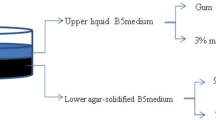Summary
A very significant improvement of the total yield of androgenetic green plants after anther culture is presented. The process involves treatment of the donor plants by spraying at different stages around the meiosis with a chemical hybridization agent (CHA) solution, fenridazon-potassium. When harvested at the normal uninucleate pollen grain stage, anthers have shown during in vitro culture very significant increases in embryo production. Compared to the control, we observed up to a 20-fold increase in the production. Moreover, when cultivated later, anthers still remained embryogenic. Therefore the process appears to be very efficient and to allow a broadening of the target period for androgenesis in vitro. The regeneration was not disturbed by the CHA treatment and, as shown in this paper, the technique seems to be applicable to a large range of genotypes. Cytological observations revealed both a low frequency of aneuploidy among the regenerated plants and peculiar features in the pollen grain walls after treatments; a triploid plant was observed. Hypotheses to explain the phenomenon are presented and related to previous observations on the effects of gametocide substances like ethrel, male sterility and pollen dimorphism on androgenesis.
Similar content being viewed by others
References
Bajaj YPS (1977) In vitro induction of haploids in wheat (Triticum aestivum L.). Crop Improv 4:54–64
Bennett MD, Hughes WG (1972) Additional mitosis in wheat pollen induced by Ethrel. Nature (London) 240:566–568
Chuang Ch Ch, Ouyang TW, Chia H, Cous S, Ching CK (1978) A set of potato media for wheat anther culture. Proc Symp Plant Tissue Culture. Science Press, Peking, pp 51–56
Colhoun CW, Steer MW (1982) Gametocide induction of male sterility: a review and observations on the site of action in the anther. Rev Cytol Biol Veg 5:283–302
De Buyser J, Picard E (1975) Observation de divisions suplémentaires dans les grains de pollen de plantes homozygotes de Blé tendre (Triticum aestivum L.) obtenues par androgénèse in vitro. CR Acad Sci Ser D 281:1153–1156
Foroughi-Wehr B, Friedt W, Wenzel G (1982) On the genetic improvement of androgenetic haploid formation in Hordeum vulgare L. Theor Appl Genet 62:233–239
Gallais A (1983) Etude de critères de sélection chez le maïs fourrage: héritabilités, corrélations génétiques et réponse attendue à la sélection Agronomie 3:751–760
Heberle-Bors E (1985) In vitro haploid formation from pollen: a critical review. Theor Appl Genet 71:361–374
Heberle-Bors E, Odenbach W (1985) In vitro pollen embryogenesis and cytoplasmic male sterility in Triticum aestivum L. Z Pflanzenzücht 95:14–22
Henry Y, de Buyser J, Guenegou T, Ory C (1984) Wheat microspore embryogenesis during in vitro anther culture. Theor Appl Genet 67:439–442
Hu H, Hsi TY, Tseng CC, Ouyang TW, Ching CK (1978) Application of anther culture to crop plants. In: Thorpe TA (ed) Frontiers of plants tissue culture 1978. Offset Print Serv, University of Galgary, Galgary, USA, pp 123–130
Hu Han (1986) Wheat: improvement through anther culture. In: Bajaj YPS (ed) Biotechnology in agriculture and forestry 2 — crops I. Springer, Berlin Heidelberg New York, pp 55–72
Lazar MD, Baenziger PS, Schaeffer GW (1984) Combining abilities and heritability of callus formation and plantlet regeneration in wheat (Triticum aestivum L.) anther cultures. Theor Appl Genet 68:131–134
McRae HH (1985) Advances in Chemical Hybridization. In: Janick j (ed) Plant breeding reviews, vol 3. Purdue University, pp 169–192
Ouyang JW, Zhou SM, Jia SE (1983) The response of anther culture to culture temperature in Triticum aestivum. Theor Appl Genet 66:101–109
Picard E (1984) Contribution à l'étude de l'hérédité et de l'utilisation en sélection de l'haploïdisation par androgenèse in vitro chez une céréale autogame: Triticum aestivum L. Thesis, Université Paris XI, France
Picard E, de Buyser J (1975) Nouveaux résultats concernant la culture d'anthères in vitro de blé tendre (Triticum aestivum L.). Effets d'un choc thermique et de la position de l'anthère sur l'épi. CR Acad Sci, ser D 281:127–130
Picard E, de Buyser J (1977) High production of embryoids in anther culture of pollen derived homozygous spring wheats. Ann Amelior Plant 24:483–488
Picard E, de Buyser J, Henry Y (1978) Technique de production d'haploïdes de Blé par culture d'anthères in vitro. Le Sélectionneur Français 26:25–37
Raquin C, Amssa M, Henry Y, de Buyser J, Essad S (1982) Origine des plantes polyploïdes obtenues par culture D'anthères. Analyse cytophotométrique in situ et in vitro des microspores de Pétunia et de Blé. Z Pflanzenzücht 89:265–277
Rives M, Picard E (1977) A case of genetic assimilation: selection through androgenesis or parthenogenesis of haploid producing systems (an hypothesis). Ann Amelior Plant 27:489–491
Schmid J, Keller ER (1986) Improved androgenetic response in wheat (Triticum aestivum) as a result of gametocide application to anther donor plants. Abstracts of the 4th Int Cong Plant Tissue Cell Culture, 3–8 August, 1986. University of Minnesota, p 146
Snape JW, de Buyser J, Henry Y, Simpson E (1986) A comparison of Methods of Haploid Production in a Cross of Wheat, Triticum aestivum L. Z. Pflanzenzücht 96:320–330
Uhrig H (1985) Genetic selection and liquid medium conditions improve the yield of androgenetic plants from diploid potatoes. Theor Appl Genet 71:455–460
Wang CC, Sun CS, Chu Z (1974) On the conditions for the induction of rice pollen plantlets and certain factors affecting the frequency of induction. Acta Bot Sin 16:43–53
Wenzel G, Uhrig H (1981) Breeding for nematode and virus resistance in potato via anther culture. Theor Appl Genet 59:333–430
Author information
Authors and Affiliations
Additional information
Communicated by G. Wenzel
Rights and permissions
About this article
Cite this article
Picard, E., Hours, C., Grégoire, S. et al. Significant improvement of androgenetic haploid and doubled haploid induction from wheat plants treated with a chemical hybridization agent. Theoret. Appl. Genetics 74, 289–297 (1987). https://doi.org/10.1007/BF00274709
Received:
Accepted:
Issue Date:
DOI: https://doi.org/10.1007/BF00274709




